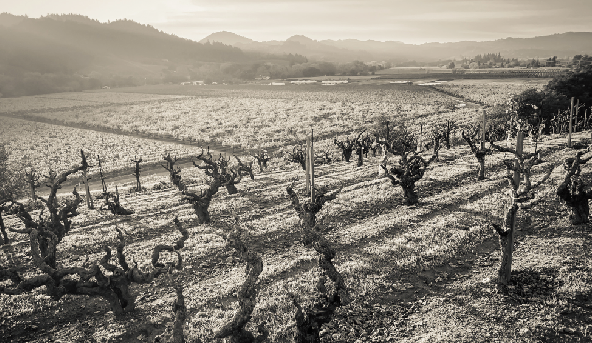Early Spring ‘22 Vineyard Notes
Good Ol’ Vines
Painting by Dana Hawley
Zinfandel is an important grape for California because it has so much history. Old-vine is not a legally regulated term and there is as much debate over what should be considered ‘old’ as debate over whether it produces better wines. What we do know is that grape vines mature around 25 to 30 years old and begin to lose vigor and crop yields as they get older. Most of the old-vines we have worked with are 50 to 100 years old and yield only about one ton per acre. Considering a young vineyard will easily produce four tons per acre, the financial incentive is to replant old vines. It is by the stewardship of dedicated farmers that we have old vineyards at all.
Zinfandel is believed to have been brought to the US in the 1820’s from Austria and mistakenly took it’s name from another grape called ‘Zierfandler’. In 2001, UC Davis researchers found a vineyard in Croatia with nine vines remaining of an ancient variety named Crljenak Kaštelanski that is a DNA match with Zinfandel. Primativo in Italy is an even closer match and they both likely came from the Croatian grape.
Zinfandel became very popular in the US and especially in California during the gold rush. It was vigorous, versatile and made a fruity table wine that did not require extended aging. By the late 1800’s, one third of all grapevines in California was Zinfandel, according to a census report. The grape was often planted as a field blend along with Alicante Bouchet, Petite Sirah and Carignan to produce a more complex wine.
The Alegria vineyard, where we source our Old Vine Zinfandel from in the Russian River Valley, was originally planted in 1890 although it has been added to since then. It is a field blend with 78% Zinfandel, 11% Alicante Bouschet, 9% Petite Sirah and 2% is comprised of more than a dozen other obscure varietals.
In the Vineyard
Early Spring in Sonoma County is characterized by the stark dormant vines, contrasted with the bright, and sometimes floral cover crops often used in organic farming practices. All over the rolling vineyards of Healdsburg we are starting to see the vibrant greens dotted with wild flowers, the most prevalent floral cover crop being wild mustard. This stunning plant grows up to three feet tall and makes for a lovely setting for photos and vineyard exploration. Not only is it beautiful, but also useful to the vines themselves. After the mustard has reached its peak, farmers disc the plants, adding much needed nutrients back into the soil, all the while keeping pests away. The natural bitter taste of the wild mustard plants keep bugs from feasting on the vines.
Our vines may be dormant but the recent heavy rains have brought Bradford Mountain to life! At Hawley Winery, we use a lovely mixture of sweet peas, bell beans, clover, and vetch in our cover crop blend. These plants are able to take nitrogen out of the air and make it into protein. If left to maturity, we would have a full garden between the vines - but we have other plans for these plants. Much like the wild mustard used around the county, our blend of cover crops will be disced into the soil, adding nitrogen back into the ground for the vines to utilize. This technique allows us to avoid using chemical fertilizers! Without the cover crops the soil would be very low in nitrogen, which is easily washed from the hillsides by the rain.
Liquid Gold
We recently entered the San Francisco Chronicle wine competition and took home many Gold Medals in one of the biggest competitions! ‘Double Gold’ means unanimous vote by all judges. We are grateful for the recognition and excited to share our wonderful new releases.
Everything but the Bagel Salmon
by Grace Parisi
Serves Two
Ingredients:
1 1/2 pounds salmon
Salt and pepper
Olive oil
2 tablespoons whole grain mustard
2 tablespoons everything spice
2 tablespoons horseradish
1 cup sour cream or creme fraiche
Directions:
COOK SALMON
Preheat the oven to 425°F with a rack in the center position. Line a sturdy baking sheet with parchment paper. Brush the skin-side of the salmon with olive oil and arrange on the baking sheet, skin-side down. Season lightly with pepper (seasoning blend has salt). Spread the mustard over top. Sprinkle the top generously with the spice blend, patting to adhere. Roast until the flesh flakes around the edges but is still slightly pink in the center, 8–10 minutes, depending on thickness.
MAKE THE SAUCE
In a small bowl, combine horseradish and sour cream and season with salt and pepper to taste. Serve salmon right away with horseradish cream, braised cabbage, and herb-roasted potatoes.
PAIR WITH
Old Vine Zinfandel, Alegria Vineyard








